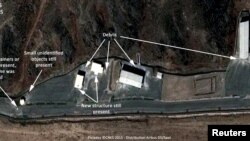The Parchin military facility is back at center stage in the Iran nuclear crisis as new satellite images show vehicles and container-like objects being moved near a location where Iran is suspected of conducting past nuclear-related tests.
The images, taken from a commercial satellite, were released to the public on June 7 by a U.S. think tank which said they suggest Iran may be trying to clean up the site ahead of a planned visit by international nuclear inspectors later this year.
Tehran has said the vehicles at the site are simply engaged in road works in the area but that explanation is not likely to put the matter to rest quickly. The reason is this is not the first time satellite images have shown possible clean-up work at the site and the issue has long been among the most sensitive ones in the controversy over Iran's nuclear activities.
The UN's nuclear watchdog, the International Atomic Energy Agency (IAEA), said in 2011 it believed Iran conducted experiments at the military facility outside Tehran more than a decade ago. It believes Iran built a container at Parchin in 2000 designed to contain the detonation of up to 70 kilograms of high explosives used to develop models for triggered nuclear reactions.
But despite the inspectors' high interest in visiting the site, Tehran refused to give them access. Tehran said Parchin was used solely for conventional-weapons testing and, as a military facility, was off-limits for national security reasons.
The repeated refusals heightened the IAEA's suspicions Iran might be hiding something and they rose further in 2012 when satellite images showed what the agency termed "extensive activities" at Parchin. The activities included the razing of two buildings and the removal and replacement of what the IAEA called "considerable" quantities of earth.
IAEA Director-General Yukia Amano noted at the time that Iran's activities "could make it much more difficult for us to undertake effective verification. Nevertheless, it is important that agency inspectors should have access to the site."
This week's satellite images are certain to revive a debate over whether Iran could so successfully remove evidence of any nuclear-related activities as to make a visit to Parchin fruitless. However, many nuclear experts say such a thorough sanitizing would be next to impossible due to the difficulty of removing all trace amounts of enriched uranium from an area.
Knowing what happened at Parchin more than a decade ago remains key to ending the nuclear crisis because the accord reached last month in Vienna stipulates that sanctions can only be lifted if Tehran resolves all of the IAEA's concerns over the possible military dimensions of its nuclear program -- both past and present.








